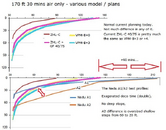Hi Kevin,
No, I was not there. But you and Simon have been touting this story as a deep stop failure, and an extension of the nedu test, when in fact its something very, very different.
Despite popular myth, there is not some hidden accumulation of slow tissue gas that creates this multi-day condition. If you are in the water 4 times a day doing 2 hour dives, its still only 6 or 8 hours in 24 hours, (20 min total deep time and 4+ hours shallow time). Its not enough to carry over any significant gas volume. Yes, the computed deco time goes up a little bit, but not by much. This notion that a few minutes of deep stops was the problem all on its own, is pure baloney and nonsense. Your suggestion that some Slow Tissue Supersaturation is the cause is just plain silly in this situation.
Your full description here is one of accumulated multi-day fatigue, where you "reached your bodies limit", and exceeded it. It is not a model failure. Its a failure of the person to follow the experience and wisdom that predicted the very occurrence.
The wisdom that you have come to realize here - is to take it easy on multi-day dives. This multi-day issue and wisdom, existed long before DIR, RD, VPM and any other deeper stop approach existed. The multi-day problem is one that affects us all, and occurs regardless of the model used.
In my opinion, The conditions here is that your body gets fatigued and exhausted over many days of big diving, and it does not perform the on/off gassing as expected, compared to when you started out on day one. If you choose to deco close to the edge, day after day, then any minor variation in your bodies response, puts you over the edge. And the result is usually a big hit, because your body is in a fatigued or weakened state when it occurs.
******
This was not a deep stop problem, This is not a VPM-B problem. This is not a bubble model theory problem. The nedu test is not relevant to any of this. This is a multi-day dive fatigue issue.
.






